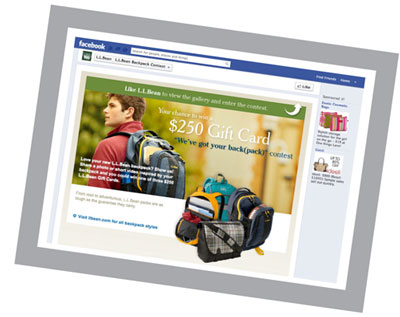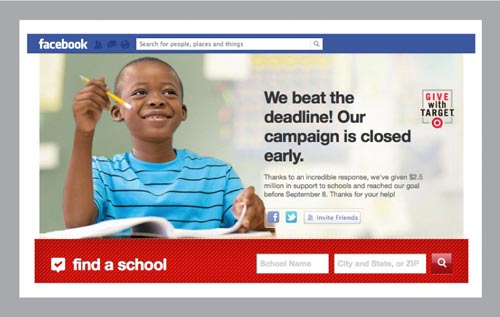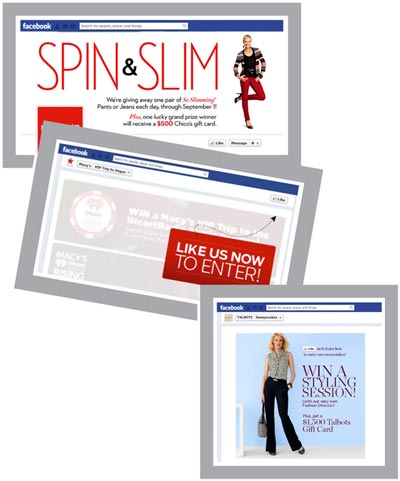Merchants employ many tactics to grow their Facebook fan bases. There are offline tactics—such as highlighting your Facebook sign-up page URL on your catalog cover, or including a link to your sign-up page in an email. But how effectively are merchants using their web pages to promote Facebook sign-ups? And, is it important to do so?
Follow US! |
Let’s first look at the ways merchants are currently leveraging their home pages to encourage Facebook sign-ups.
Footer Link: Most Common, Least Engaging Method
The majority of merchants place their Facebook links in the footer of their website home pages. This approach gives potential site visitors an easy way to become fans, but it is a rather passive invitation to become involved with the brand. The social platform links blend into to the rest of the footer links, which are typically links to more information pages.
Sears and Gap are two examples of merchants using this approach. They grew their fan bases by a modest 0.5% (+1K) and 1% (+18.6K), respectively, from Aug. 20 to 27, the week I reviewed all the Facebook pages mentioned in this article.
Header and Footer Links: More Opportunities, Greater Results
Taking it beyond just the footer link are merchants that also include the Facebook sign-up page link at the top of the home pages, as do both HSN and Blackberry. This offers a second opportunity to sign up. It is no more promotional than just having the link in the footer, but it does provide more visibility. HSN and Blackberry grew their fan bases by 12% (+1.7K) and 3% (+36K), respectively, during the week we reviewed.
Offering Incentives in Exchange for Likes
Savvy merchants are also integrating apps into their Facebook pages that require liking a page in order to enter a contest or be included in a drawing for a give-away. This strategy is designed to assure that the clickthrough from the home page to the Facebook page actually converts into a like. L.L. Bean, Macy’s and Chico’s are merchants using more aggressive fan-growth initiatives.
L.L. Bean recently offered consumers an opportunity to enter a drawing for a backpack or a $250 gift card if they sent in a photo or short video inspired by their backpacks. During the week of our review, its fan based grew by 0.5%. (+611K)

Chico’s ran a “Spin & Slim” promotion offering a chance to win a pair of its “So Slimming” pants or jeans, plus a grand prize $500 gift card if entrants “liked” its Facebook page. Chico’s is currently growing its fan base at a rate of 8% a week (+14.4K).
Macy’s ran a promotion recently for a VIP trip to Las Vegas. The national retailer is currently experiencing a 4% increase (+256K) in fans week over week.
Talbots also ran a contest recently offering a chance to win a styling session or a grand prize $1,500 credit card if entrants “liked” its Facebook page. During the week our review, the fan based grew by 6%. (+13.6K).
Charitable Contributions in Exchange for Likes
Target’s Facebook fan base is growing by 3% week-over-week (+500K). The growth may be attributed in part to a very successful “Give with Target” campaign in which Target is awarding $2.5 million in grants to schools across the country, resulting from enthusiasts “liking” its page and then simply choosing and voting for a K-12 school from a list of eligible schools. Schools will receive a $25 Target Gift Card for every 25 votes received.

Build It and They Will Come
There are merchants who, while they have Facebook pages, don’t have a link to sign up on their home pages. Amazon is one such example. There is no mention of Facebook on its home page, but Amazon now has 9.9 million fans and a growth rate of 3% (+279K) a week. This seems to indicate that if there is an interest in your brand, your Facebook page will be discovered regardless of where you place a link to the sign-up page. Well-placed links make it convenient to sign up, but it is really brand sentiment that turns a clickthrough into a like.

The Value of a Like
Forrester Research recently published a “Facebook Factor” study, authored by analyst Gina Sverdlov. In her conclusion she said, “The largest effect of being a Facebook fan on buying from these brands indicates the strength of the relationship between fandom and purchase—but many consumers who engage with these brands on Facebook may already be regular shoppers.”
With all the recent talk about the monetization of Facebook, it makes sense for merchants to take full advantage of their fans’ interest in their brands, regardless of why or how they decided to go about ‘liking” the brand. It starts with a solid engagement strategy. Engagement is a measure of how well advertisers are interacting with followers using relevant content. To measure relevancy, advertisers should understand how consumers are reacting to original advertiser posts; they can do this by looking at the average number of comments and likes per post, as well as the sentiments the comments express.
I heartedly agree with a key take-away that Sverdlov pointed out in her study: “Brand engagement is a driver of loyalty and purchase for companies, and Facebook is a great channel for advocates to share brand experiences with others. Facebook, therefore, should be a leading platform when launching a brand advocacy program. Companies should create social content that will keep fans engaged with the brand.”
Janice Smithers ([email protected]) is director of reporting and analytics at Covario (covario.com).